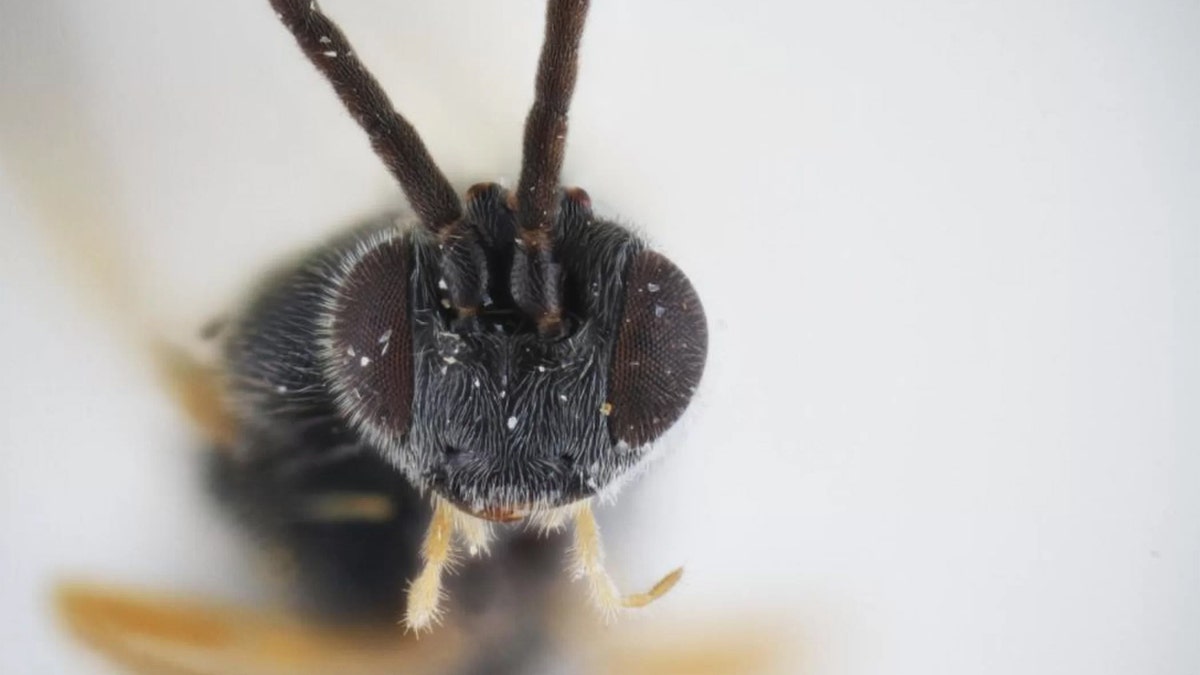
This is the parasitic wasp Dolichogenidea xenomorph. Credit: Photo by Erinn Fagan-Jeffries
The inspiration for the chestburster creature from "Alien," a rare subfamily of parasitoid wasps reproduces by literally inserting or injecting its eggs into unsuspecting caterpillars, which leads to the eggs literally eating their way to freedom.
According to research published in the Journal of Hymenoptera Research, three new species of Microgastrinae wasps have been named, one of which has been given the name Dolichogenidea xenomorph, xenomorph being the name of the creature in the 1979 sci-horror movie, "Alien."
"Dolichogenidea xenomorph acts as a parasite in caterpillars in a similar way that the fictional Alien creature does in its human host," lead researcher Dr. Erinn Fagan-Jeffries of the University of Adelaide's School of Biological Sciences said in a statement.
ZOMBIE ANTS ARE SCARIER THAN YOU EVER IMAGINED
"The wasp is also black and shiny like the alien, and has a couple of weird traits for the genus -- so xenomorph, meaning 'strange form', fits really well," Dr. Fagan-Jefferies added.
D. xenomorph is tiny, at just 0.2 inches (5 millimeters) long, but it sports a pair of black antennae that are more than double its body length. Females are equipped with an "extremely long" ovipositor, which allows them to inject the eggs into the unsuspecting hosts, the researchers noted.
In addition to the D. xenomorph, the researchers describe two others, Dolichogenidea finchi and Dolichogenidea mediocaudata, but it's the D. xenomorph that is understandably grabbing the majority of attention.
"This species is named for the fictional creature from the movie franchise 'Alien,' which reportedly was inspired by the lifecycle of parasitic wasps," the researchers wrote in their paper. "The name of the fictional creature comes from the Greek 'xeno' (strange) and 'morphe' (form) which is also appropriate."
Researchers believe that there could be as many as 10,000 Microgastrinae wasps across the planet, but only a few thousand have actually been identified, LiveScience reports.
Female D. xenomorph wasps generally insert their eggs into Australian moth caterpillars known as Antipterna euanthes. The female D. xenomorph inserts dozens of tiny eggs into the caterpillars and after they hatch, the begin to eat the host body from the inside. Or in the words of actor Tom Skerrit who played the character Dallas in the movie, "like he exploded from inside."
Once they've gorged on their fair share of blood and there is no additional room inside the moth caterpillar to grow, the larvae chew through the body in the span of a few weeks. From there, they spin a communal cocoon as they begin their next development phase, the researchers added.
Assuming the caterpillar doesn't die after the xenomorph larvae burst through, it could be a bodyguard for the newly hatched wasps, LiveScience added. Eventually, the caterpillar does die (poor zombie caterpillar) and the cycle repeats, with the newly formed xenomorphs looking for additional hosts.
WASPS BRED AS BIOLOGICAL WARFARE AGENTS
It's unclear exactly how widespread the species is (so far, they've only been found at southeastern and southwestern coasts of Australia, according to the researchers), but its ferocity is unquestioned.
"At less than 5mm in length, Dolichogenidea xenomorph might seem to lack the punch of its fearsome namesake," Fagan-Jeffries said. "But size is relative; to a host caterpillar, it's an awesome predator."
Follow Chris Ciaccia on Twitter @Chris_Ciaccia